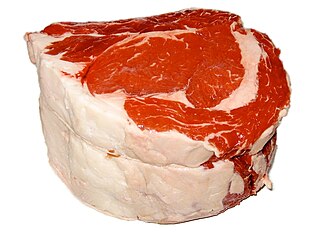
Beef is the culinary name for meat from cattle. Beef can be prepared in various ways;cuts are often used for steak,which can be cooked to varying degrees of doneness,while trimmings are often ground or minced,as found in most hamburgers. Beef contains protein,iron,and vitamin B12. Along with other kinds of red meat,high consumption is associated with an increased risk of colorectal cancer and coronary heart disease,especially when processed. Beef has a high environmental impact,being a primary driver of deforestation with the highest greenhouse gas emissions of any agricultural product.

Escherichia coli ( ESH-ə-RIK-ee-əKOH-ly) is a gram-negative,facultative anaerobic,rod-shaped,coliform bacterium of the genus Escherichia that is commonly found in the lower intestine of warm-blooded organisms. Most E. coli strains are harmless,but some serotypes such as EPEC,and ETEC are pathogenic and can cause serious food poisoning in their hosts,and are occasionally responsible for food contamination incidents that prompt product recalls. Most strains are part of the normal microbiota of the gut and are harmless or even beneficial to humans (although these strains tend to be less studied than the pathogenic ones). For example,some strains of E. coli benefit their hosts by producing vitamin K2 or by preventing the colonization of the intestine by pathogenic bacteria. These mutually beneficial relationships between E. coli and humans are a type of mutualistic biological relationship —where both the humans and the E. coli are benefitting each other. E. coli is expelled into the environment within fecal matter. The bacterium grows massively in fresh fecal matter under aerobic conditions for three days,but its numbers decline slowly afterwards.

Escherichia coli O157:H7 is a serotype of the bacterial species Escherichia coli and is one of the Shiga-like toxin–producing types of E. coli. It is a cause of disease,typically foodborne illness,through consumption of contaminated and raw food,including raw milk and undercooked ground beef. Infection with this type of pathogenic bacteria may lead to hemorrhagic diarrhea,and to kidney failure;these have been reported to cause the deaths of children younger than five years of age,of elderly patients,and of patients whose immune systems are otherwise compromised.

Shiga toxins are a family of related toxins with two major groups,Stx1 and Stx2,expressed by genes considered to be part of the genome of lambdoid prophages. The toxins are named after Kiyoshi Shiga,who first described the bacterial origin of dysentery caused by Shigella dysenteriae. Shiga-like toxin (SLT) is a historical term for similar or identical toxins produced by Escherichia coli. The most common sources for Shiga toxin are the bacteria S. dysenteriae and some serotypes of Escherichia coli (STEC),which includes serotypes O157:H7,and O104:H4.

DNA polymerase I is an enzyme that participates in the process of prokaryotic DNA replication. Discovered by Arthur Kornberg in 1956,it was the first known DNA polymerase. It was initially characterized in E. coli and is ubiquitous in prokaryotes. In E. coli and many other bacteria,the gene that encodes Pol I is known as polA. The E. coli Pol I enzyme is composed of 928 amino acids,and is an example of a processive enzyme —it can sequentially catalyze multiple polymerisation steps without releasing the single-stranded template. The physiological function of Pol I is mainly to support repair of damaged DNA,but it also contributes to connecting Okazaki fragments by deleting RNA primers and replacing the ribonucleotides with DNA.

Hemolytic–uremic syndrome (HUS) is a group of blood disorders characterized by low red blood cells,acute kidney failure,and low platelets. Initial symptoms typically include bloody diarrhea,fever,vomiting,and weakness. Kidney problems and low platelets then occur as the diarrhea progresses. Children are more commonly affected,but most children recover without permanent damage to their health,although some children may have serious and sometimes life-threatening complications. Adults,especially the elderly,may present a more complicated presentation. Complications may include neurological problems and heart failure.

A facultative anaerobic organism is an organism that makes ATP by aerobic respiration if oxygen is present,but is capable of switching to fermentation if oxygen is absent.

Balantidium is a genus of ciliates. It contains the parasitic species Balantidium coli,the only known cause of balantidiasis.

Coliform bacteria are defined as either motile or non-motile Gram-negative non-spore forming Bacilli that possess β-galactosidase to produce acids and gases under their optimal growth temperature of 35-37 °C. They can be aerobes or facultative aerobes,and are a commonly used indicator of low sanitary quality of foods,milk,and water. Coliforms can be found in the aquatic environment,in soil and on vegetation;they are universally present in large numbers in the feces of warm-blooded animals as they are known to inhabit the gastrointestinal system. While coliform bacteria are not normally causes of serious illness,they are easy to culture,and their presence is used to infer that other pathogenic organisms of fecal origin may be present in a sample,or that said sample is not safe to consume. Such pathogens include disease-causing bacteria,viruses,or protozoa and many multicellular parasites.

Romaine or cos lettuce is a variety of lettuce that grows in a tall head of sturdy dark green leaves with firm ribs down their centers. Unlike most lettuces,it is tolerant of heat. In North America,romaine is often sold as whole heads or as "hearts" that have had the outer leaves removed and are often packaged together.
Enterotoxigenic Escherichia coli (ETEC) is a type of Escherichia coli and one of the leading bacterial causes of diarrhea in the developing world,as well as the most common cause of travelers' diarrhea. Insufficient data exists,but conservative estimates suggest that each year,about 157,000 deaths occur,mostly in children,from ETEC. A number of pathogenic isolates are termed ETEC,but the main hallmarks of this type of bacterium are expression of one or more enterotoxins and presence of fimbriae used for attachment to host intestinal cells. The bacterium was identified by the Bradley Sack lab in Kolkata in 1968.
Enteroinvasive Escherichia coli (EIEC) is a type of pathogenic bacteria whose infection causes a syndrome that is identical to shigellosis,with profuse diarrhea and high fever. EIEC are highly invasive,and they use adhesin proteins to bind to and enter intestinal cells. They produce no toxins,but severely damage the intestinal wall through mechanical cell destruction.
The Coli Toro Member is a Campanian geologic member in Argentina. Dinosaur remains are among the fossils that have been recovered from the formation,although none have yet been referred to a specific genus. The sandstones of the formation were deposited in a lacustrine environment.

A novel strain of Escherichia coli O104:H4 bacteria caused a serious outbreak of foodborne illness focused in northern Germany in May through June 2011. The illness was characterized by bloody diarrhea,with a high frequency of serious complications,including hemolytic–uremic syndrome (HUS),a condition that requires urgent treatment. The outbreak was originally thought to have been caused by an enterohemorrhagic (EHEC) strain of E. coli,but it was later shown to have been caused by an enteroaggregative E. coli (EAEC) strain that had acquired the genes to produce Shiga toxins,present in organic fenugreek sprouts.
Escherichia coli O104:H4 is an enteroaggregative Escherichia coli strain of the bacterium Escherichia coli,and the cause of the 2011 Escherichia coli O104:H4 outbreak. The "O" in the serological classification identifies the cell wall lipopolysaccharide antigen,and the "H" identifies the flagella antigen.
Shigatoxigenic Escherichia coli (STEC) and verotoxigenic E. coli (VTEC) are strains of the bacterium Escherichia coli that produce Shiga toxin. Only a minority of the strains cause illness in humans. The ones that do are collectively known as enterohemorrhagic E. coli (EHEC) and are major causes of foodborne illness. When infecting the large intestine of humans,they often cause gastroenteritis,enterocolitis,and bloody diarrhea and sometimes cause a severe complication called hemolytic-uremic syndrome (HUS). Cattle is an important natural reservoir for EHEC because the colonised adult ruminants are asymptomatic. This is because they lack vascular expression of the target receptor for Shiga toxins. The group and its subgroups are known by various names. They are distinguished from other strains of intestinal pathogenic E. coli including enterotoxigenic E. coli (ETEC),enteropathogenic E. coli (EPEC),enteroinvasive E. coli (EIEC),enteroaggregative E. coli (EAEC),and diffusely adherent E. coli (DAEC).

Escherichia coli is a gram-negative,rod-shaped bacterium that is commonly found in the lower intestine of warm-blooded organisms (endotherms). Most E. coli strains are harmless,but pathogenic varieties cause serious food poisoning,septic shock,meningitis,or urinary tract infections in humans. Unlike normal flora E. coli,the pathogenic varieties produce toxins and other virulence factors that enable them to reside in parts of the body normally not inhabited by E. coli,and to damage host cells. These pathogenic traits are encoded by virulence genes carried only by the pathogens.
In 2006,there were several outbreaks of foodborne illness from spinach and lettuce contaminated by E. coli O157:H7.

The 1992–1993 Jack in the Box E. coli outbreak occurred when the Escherichia coli O157:H7 bacterium killed four children and infected 732 people across four states. The outbreak involved 73 Jack in the Box restaurants in California,Idaho,Washington,and Nevada,and has been described as "far and away the most infamous food poison outbreak in contemporary history." The majority of the affected were under 10 years old. Four children died and 178 others were left with permanent injury including kidney and brain damage.









